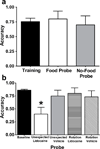Remembering the past and planning for the future in rats
- PMID: 23219951
- PMCID: PMC3582767
- DOI: 10.1016/j.beproc.2012.11.014
Remembering the past and planning for the future in rats
Abstract
A growing body of research suggests that rats represent and remember specific earlier events from the past. An important criterion for validating a rodent model of episodic memory is to establish that the content of the representation is about a specific event in the past rather than vague information about remoteness. Recent evidence suggests that rats may also represent events that are anticipated to occur in the future. An important capacity afforded by a representation of the future is the ability to plan for the occurrence of a future event. However, relatively little is known about the content of represented future events and the cognitive mechanisms that may support planning. This article reviews evidence that rats remember specific earlier events from the past, represent events that are anticipated to occur in the future, and develops criteria for validating a rodent model of future planning. These criteria include representing a specific time in the future, the ability to temporarily disengage from a plan and reactivate the plan at an appropriate time in the future, and flexibility to deploy a plan in novel conditions.
Copyright © 2012 Elsevier B.V. All rights reserved.
Figures






Similar articles
-
[Remembering past events activates temporal concepts of future].Shinrigaku Kenkyu. 2015 Oct;86(4):340-6. doi: 10.4992/jjpsy.86.14315. Shinrigaku Kenkyu. 2015. PMID: 26562943 Japanese.
-
The temporal compression of events during episodic future thinking.Cognition. 2020 Dec;205:104416. doi: 10.1016/j.cognition.2020.104416. Epub 2020 Aug 6. Cognition. 2020. PMID: 32773151
-
Remembering the past and imagining the future: examining the consequences of mental time travel on memory.Memory. 2012;20(3):224-35. doi: 10.1080/09658211.2012.654796. Epub 2012 Feb 23. Memory. 2012. PMID: 22360761
-
[Studying episodic memory : dogs as a biological model ?].Med Sci (Paris). 2017 Dec;33(12):1089-1095. doi: 10.1051/medsci/20173312016. Epub 2017 Dec 20. Med Sci (Paris). 2017. PMID: 29261497 Review. French.
-
Mental time travel in animals: a challenging question.Behav Processes. 2006 May 1;72(2):173-83. doi: 10.1016/j.beproc.2006.01.009. Epub 2006 Feb 8. Behav Processes. 2006. PMID: 16466863 Review.
Cited by
-
The relationship between event-based prospective memory and ongoing task performance in chimpanzees (Pan troglodytes).PLoS One. 2014 Nov 5;9(11):e112015. doi: 10.1371/journal.pone.0112015. eCollection 2014. PLoS One. 2014. PMID: 25372809 Free PMC article.
-
Still searching for the engram.Learn Behav. 2016 Sep;44(3):209-22. doi: 10.3758/s13420-016-0218-1. Learn Behav. 2016. PMID: 26944423 Free PMC article. Review.
-
Episodic Memory as a Propositional Attitude: A Critical Perspective.Front Psychol. 2018 Jul 18;9:1220. doi: 10.3389/fpsyg.2018.01220. eCollection 2018. Front Psychol. 2018. PMID: 30072933 Free PMC article. Review.
-
Chimpanzee food preferences, associative learning, and the origins of cooking.Learn Behav. 2016 Jun;44(2):103-8. doi: 10.3758/s13420-015-0206-x. Learn Behav. 2016. PMID: 26659967 Free PMC article. Review.
-
Rats Remember Items in Context Using Episodic Memory.Curr Biol. 2016 Oct 24;26(20):2821-2826. doi: 10.1016/j.cub.2016.08.023. Epub 2016 Sep 29. Curr Biol. 2016. PMID: 27693137 Free PMC article.
References
-
- Addis DR, Schacter DL. Constructive episodic simulation: Temporal distance and detail of past and future events modulate hippocampal engagement. Hippocampus. 2008;18:227–237. - PubMed
-
- Babb SJ, Crystal JD. Discrimination of what, when, and where is not based on time of day. Learning & Behavior. 2006;34:124–130. - PubMed
-
- Babb SJ, Crystal JD. Episodic-like memory in the rat. Current Biology. 2006;16:1317–1321. - PubMed
-
- Bäckman L, Andersson JL, Nyberg L, Winblad B, Nordberg A, Almkvist O. Brain regions associated with episodic retrieval in normal aging and Alzheimer's disease. Neurology. 1999;52:1861–1870. - PubMed
Publication types
MeSH terms
Grants and funding
LinkOut - more resources
Full Text Sources
Other Literature Sources
Miscellaneous

